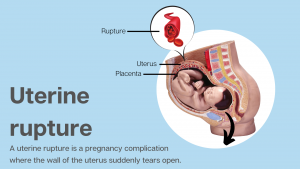A doctor’s failure to properly handle uterine rupture symptoms during childbirth can lead to the death of the child, and injury or death to the mother. This article discusses these cases and addresses:
- The acts of a physician that lead to vaginal rupture cases.
- The types of accidents that lead to large settlements and verdicts.
OVERVIEW OF BIRTH INJURY CASES INVOLVING UTERINE RUPTURE
Uterine ruptures are one of the most tragic and devastating types of birth injuries because it commonly leads to permanent injury or death. This birth injury can be caused by a number of negligent acts on the part of your physician and can occur at any stage of a pregnancy or birth.
However, this deadly accident is most common during delivery when the doctor fails to properly react to the onset of vaginal scar tearing by timely performing an emergency C-section. In this case, the baby will experience rapid oxygen loss and normally die. In addition, the mother may have to undergo a hysterectomy or other surgical procedures causing irreparable physical and emotional damage.
A uterine rupture is most common in women undergoing a vaginal birth after they have previously given birth via C-section, especially if the doctor uses a labor-inducing drug like Pitocin. The American Family Physicians Center indicates that between 0.2 and 1.5 percent of women who undergo a vaginal birth after C-section will experience a uterine rupture and the percentage increases greatly in women who have undergone multiple C-Sections.
In all pregnancies, a uterine rupture occurs in about 5 out of 1000 pregnancies. Although the occurrence of this birth injury is statistically low, the number of uterine ruptures that lead to permanent physical injury or death is extremely troubling.
It is widely accepted in the medical community that a uterine scar and the use of uterotonic agents for induction are the most important risk factors identified for uterine rupture. Physicians and nurses who are practicing in labor and delivery must understand that a woman with a classic C-section scar or using or taking uterotonic agents who are is experiencing uterine contractions, uterine irritability, or significant abdominal pain are increased risk for partial or complete uterine rupture.
WHEN UTERINE RUPTURE ACCIDENTS OCCUR
The following are examples of uterine rupture accidents:
- A doctor fails to properly advise a woman of the risk of vaginal birth after C-section and during labor experiences a uterine rupture. The uterine rupture causes the baby to lose oxygen and die.
- During labor, the doctor ignores the signs of a uterine rupture onset and continues with a vaginal birth. The mother experiences severe blood loss and a uterine rupture. As a result, she is forced to undergo an emergency hysterectomy.
- The doctor fails to follow the standard of care during a C-section. During labor, the baby suffers from severe oxygen loss and is born with almost no heartbeat. The baby is diagnosed with cerebral palsy.
EXAMPLE UTERINE RUPTURE MALPRACTICE LAWSUIT
Samantha, who delivered two other children via caesarian-section (“C-section”), opts for a vaginal birth for the birth of her third child. Her doctor properly warns her of the various risks of vaginal birth after a C-section (VBAC), including the risk of a uterine rupture, but she elects to have a natural birth. Samantha signs a consent form indicating that she is aware of the various risks. The doctor properly monitors her throughout her pregnancy and he schedules the inducement of her child’s birth.
Samantha and her husband arrive at the hospital for labor induction. The induction is begun in the morning, but her water does not break until the following morning. After her water breaks, her doctor gives her the contraction-inducing drug Pitocin. After a few hours of labor have passed, she starts experiencing severe pain. In response, her doctor administers Demerol. Despite the drug, the pain persists.
The labor continues for multiple hours. During that time, she experiences a number of complications that are considered minor for a person who is not at risk of a uterine rupture but should be cause for concern in her case. Despite the clear signs, her doctor fails to properly address the complications and continues with the vaginal birth plan because the baby’s heart rate is stable. The doctor does not ask Samantha whether she would like to proceed with a C-section and Samantha continues to dilate.
As Samantha is almost fully dilated, she suddenly throws up and the baby’s heart rate drops. The baby has late decelerations. Late decelerations are a classic sign of uterine rupture. They require intensive evaluation, including specifically internal monitoring. The doctor delays and then finally perform an emergency C-section. The C-section was performed properly, and the baby is delivered within minutes. Nevertheless, she experiences a uterine rupture and is forced to undergo an emergency hysterectomy. Subsequently, Samantha learns that because of the uterine rupture her child suffered severe oxygen loss, and, as a result, her child was born with cerebral palsy.
GETTING HELP WITH YOUR CASE
If you have suffered from medical malpractice, there is a lot of swirling in your mind. If you have questions, we may have the answers you are looking for. Call 800-553-8082 or get a free online consultation here.
 Lawsuit Information Center
Lawsuit Information Center


